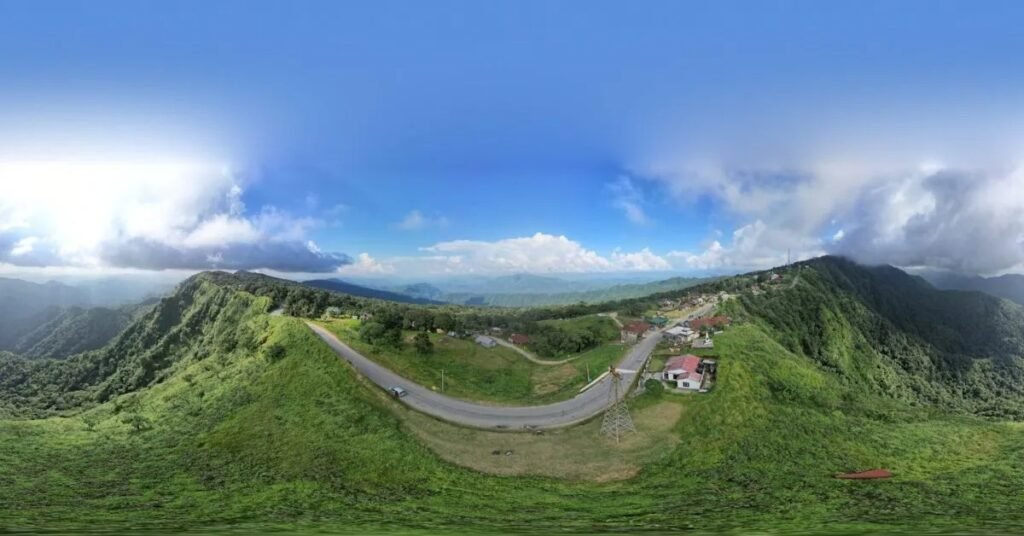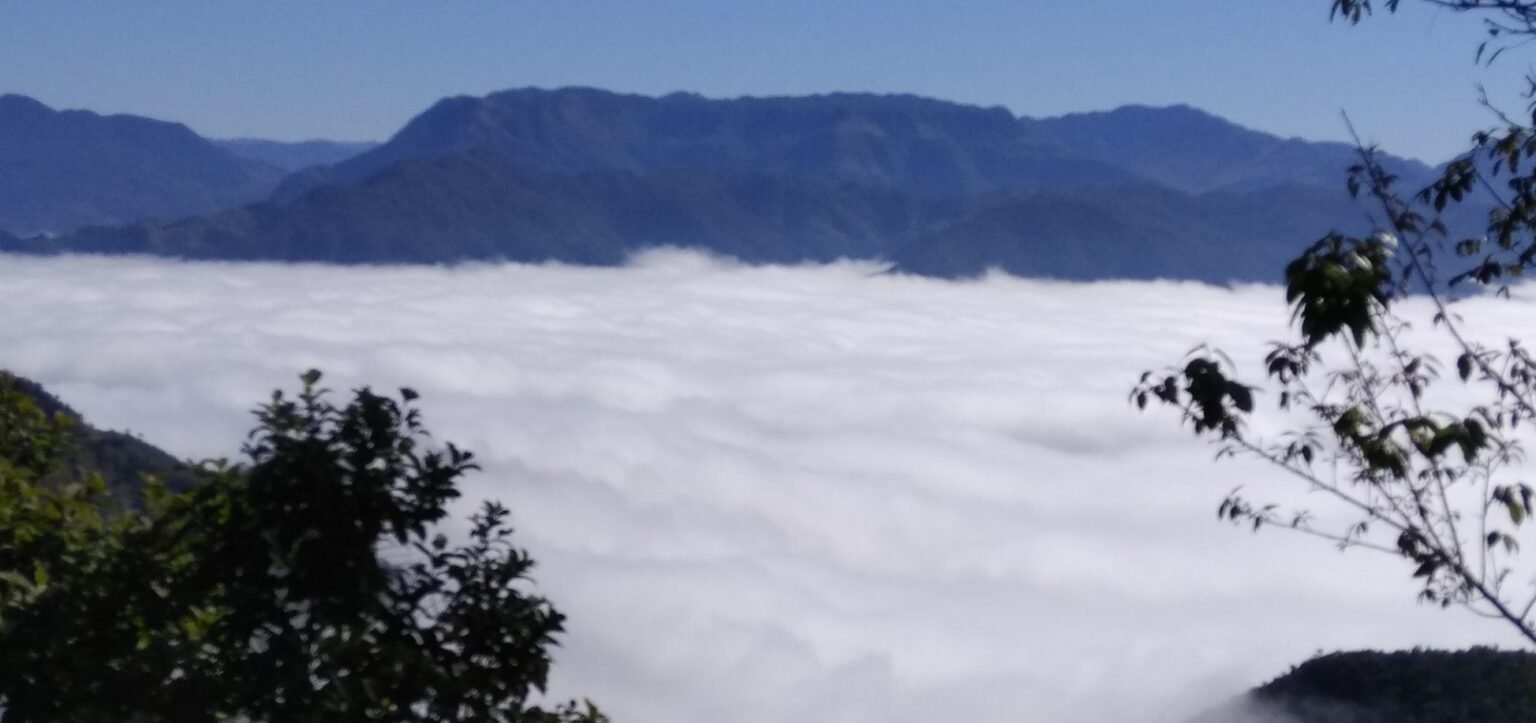Phawngpui, also known as the Blue Mountain, is the highest natural point in Mizoram, India. Revered for its breathtaking scenery, mystical folklore, and rich biodiversity, Phawngpui stands as one of Northeast India’s most treasured ecological and cultural landmarks.
Location and Geography
It is nestled in the Lawngtlai district in southeastern Mizoram, close to the Myanmar border. Rising to 2,157 meters, it’s the state’s highest peak, surrounded by the Phawngpui National Park, a protected area brimming with endemic plant and animal life. The semi-circular cliffs, known as Thlazuang Khàm, form the mountain’s dramatic western face, while the Chhimtuipui River flows nearby, enhancing its scenic appeal.
How to Reach
Phawngpui can be reached via air, rail, and road:
- Air: Lengpui Airport (450 km away in Aizawl)
- Rail: Bairabi Railway Station (600 km from Phawngpui)
- Road: Lawngtlai Bus Stop is the main access, 150 km away. Private vehicles, hired jeeps, and taxis operate to Sangau and Thaltlang villages.
Tourism authorities recommend light vehicles for the motorable track approaching the base villages. Guest houses, homestays, and eco-lodges are available in the Lawngtlai district.
Key Details:
Historical Significance
Phawngpui holds deep cultural and spiritual value among local Mizo communities. Traditionally, it has been seen as the abode of spirits and deities, woven into countless folktales and legends. The name itself stems from Lai language words for “great meadow,” referring to the mountain’s grassy slopes and spiritual greatness. One well-known legend tells of a deity king named Sangau, who exchanged gifts with other clan royalty. This tale is reflected in the place names and customs observed at Phawngpui’s base.
Cultural Landscape
Phawngpui’s culture shines through vibrant festivals and tight-knit community bonds. Popular events such as Chapchar Kut (the harvest festival) and Lui Ngai Ni (honouring warrior Laldenga) bring locals together in spirited dance and music gatherings. Traditional occupations like weaving, farming, and carpentry remain strong, blending heritage with modern entrepreneurship as tourism grows.
Folklore persists as a living art form: elders narrate stories of the Blue Fairy believed to dwell in hidden caves, and the “Tremot Raja,” a water spirit haunting Tamdil Lake, is part of the valley’s rich verbal tapestry.
Flora and Fauna
Phawngpui National Park is known for its striking biodiversity. Dense bamboo groves, wild orchids (some threatened by illegal collection), and miles of pristine grasslands shelter rare species. Notable wildlife includes:
- Clouded leopard (rarely spotted but confirmed)
- Mountain goats, barking deer, sambar, goral, serow
- Kaleej pheasant, Blyth’s tragopan, Mrs Hume’s pheasant
- Hornbill, sunbirds, barbet, dark-rumped swift, black eagle
- Hollock gibbon, common langur, rhesus macaque
The Farpak grassland is a birdwatcher’s paradise. Orchids and other unique plants thrive, making Phawngpui essential for botany studies and wildlife conservation.
Tourist Spots and Attractions
Travellers are drawn to Phawngpui for its natural beauty and adventure-laden opportunities. Key sites include:
- Thlazuang Khàm Cliff: Sharp, semi-circular cliffs famed for stunning vistas and folklore about spirits.
- Farpak Grassland Area: Ideal for bird-watching and spotting rare wildlife.
- Sangau and Thaltlang Villages: Base for treks and cultural immersion.
- Kungawrhi Puk Cave: Historical cave linked to local legends.
- Tamdil Lake: Water activities and mystical tales about Tremot Raja.
- Chapchar Kut Festival Grounds: For experiencing Mizoram’s cultural vibrance.
Nearby attractions within 100 km include Saikuti Hall, Zobawk Sports Academy, Theiriat Tlang, Solomon’s Temple, Vantawng Falls, Reiek Heritage Village, Durtlang Hills, Mizoram State Museum, KV Paradise (“Mizo Taj Mahal”), and Khawnglung Wildlife Sanctuary.

Trekking and Adventure
Phawngpui is a trekker’s dream, with paths winding through forests, meadows, and cliffs. Popular treks begin from Thaltlang, passing through Sentifiang and Sangau, and lead to the peak. Park authorities permit eco-friendly trekking only from November to April to protect delicate habitats.
Activities for adventure seekers:
- Trekking and guided treks to Phawngpui Peak (The Blue Mountain)
- Bird-watching and wildlife photography
- Ziplining, paragliding, and kayaking near the Tamdil River during the tourist season
Tourism Revenue and Economic Impact
Phawngpui’s steady rise as an eco-tourism hotspot significantly boosts Mizoram’s economy. Visitor footfall increased by 139.50% in 2024–25, establishing new benchmarks for tourism in the region. Activities like guided tours, craft shopping, homestays, and local festival participation contribute to revenue and job creation for nearby communities and local businesses.
Conservation Efforts
Phawngpui National Park remains under strict protection by state and national authorities, allowing tourist visits only in eco-friendly formats and during defined months (November–April). Efforts to combat illegal orchid collection and active reforestation are ongoing to preserve the habitat for future generations.
List of Important Places in and Around Phawngpui
FAQs About Phawngpui
What is Phawngpui famous for?
Phawngpui is renowned for being Mizoram’s highest peak, its unique flora and fauna, its mystical folklore, and its importance as a centre for culture and eco-tourism.
How do travellers reach Phawngpui?
Travellers reach Phawngpui via air through Lengpui Airport, by train (Bairabi Railway Station), and by road (Lawngtlai Bus Stop). Private vehicles bring visitors to Sangau and Thaltlang at the mountain’s base.
Which months are best for visiting?
Eco-friendly tourism is allowed from November to April. These months are recommended due to optimal weather and conservation protocols.
What wildlife can be spotted in Phawngpui National Park?
Rare species such as clouded leopard, mountain goats, peregrine falcon, Blyth’s tragopan, Mrs Hume’s pheasant, hornbill, and exotic orchids make Phawngpui a must-visit destination for nature enthusiasts.
What are the cultural highlights of Phawngpui?
The region’s Chapchar Kut and Lui Ngai Ni festivals, local weaving traditions, spiritual folklore about the Blue Fairy, and vibrant village life define Phawngpui’s cultural landscape.
What places are there to see near Phawngpui?
Nearby attractions include Kungawrhi Puk Cave, Tamdil Lake, Saikuti Hall, Vantawng Falls, Solomon’s Temple, Reiek Heritage Village, Durtlang Hills, KV Paradise, and Khawnglung Wildlife Sanctuary.
How does Phawngpui benefit the local economy?
Phawngpui’s growing status as an eco-tourism hub has led to rising tourism revenue, new jobs, and thriving local businesses in hospitality, crafts, and cultural programming.
What are the conservation strategies in place?
Controlled tourism, limited visiting months, protection of endangered species, anti-poaching and anti-collection campaigns, and community-led reforestation summarise the park’s conservation measures.

